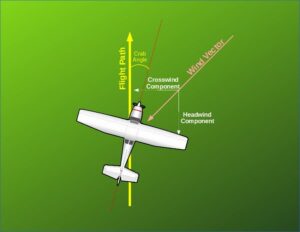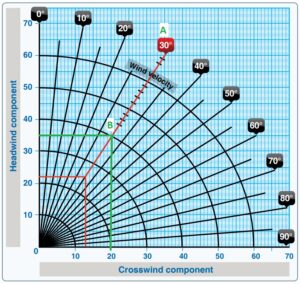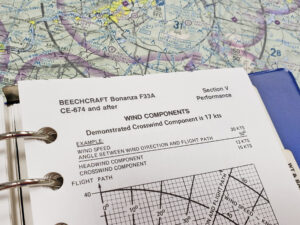 As aviators, we are required to interpret numerous charts for planning purposes. One item that is frequently misunderstood is how to determine the crosswind component. This blog explains how to determine the headwind and crosswind component for a given set of conditions by using the wind component chart.
As aviators, we are required to interpret numerous charts for planning purposes. One item that is frequently misunderstood is how to determine the crosswind component. This blog explains how to determine the headwind and crosswind component for a given set of conditions by using the wind component chart.
When an aircraft is certified, a pilot tests the crosswind capability with a 90-degree crosswind of at least .2 times VSO. The maximum demonstrated crosswind component is published in the aircraft flight manual or pilots operating handbook. It is important to note that even though the maximum demonstrated crosswind component is not regulatory or limiting, it would be wise to consider it when determining aircraft performance.
Unless the wind at a given airport is blowing straight does the runway, the wind velocity is split into two vector components: the headwind component and the crosswind component. The crosswind component is critical in helping the pilot determine whether it is safe to land on the runway or at an airport. If the magnitude of the crosswind is too great, the pilot could lose control and the aircraft could potentially drift off the runway.
Lets take a look at the how a wind component chart is used. From that information, the pilot can decide whether it is wise to continue with the landing.
On a crosswind chart, the vertical axis represents the headwind component of the wind and the horizontal axis represents the crosswind component. The diagonal lines represent the angular difference between the runway heading and direction the wind is coming from. The curved lines depict the total wind velocity. Note that when reading the total wind velocity, follow the shape of the arcs from either axis instead of tracing vertically or horizontally to the axes. Tracing vertically or horizontally leads to the crosswind and headwind components, respectively.

For example, let’s say that you are on final for Runway 18, and the winds are 210° at 40 knots.
In order to calculate the crosswind and headwind components, we first need to determine the difference between the runway heading and the direction the wind is coming from. In our scenario, take the wind direction of 210° and subtract the runway heading of 180°, giving us a difference of 30°.
Now that we have the difference in angle, 30°, and the total wind velocity, 40 knots, we can determine the crosswind and headwind components with the chart. Locate the 30° diagonal line on the chart starting at point A, and follow that 30° line towards the center until the line intersects the 40-knot arc at point B.
Once we have determined this point, we can trace horizontal and vertical lines to read the value of both the headwind and crosswind components, respectively. In this example, the headwind component is 35 knots and the crosswind component is 20 knots.
 If our airplane has a maximum demonstrated crosswind component of 17 knots, we should evaluate whether the current conditions are beyond our capabilities. It is important to exercise good judgment in such a scenario and err on the side of caution. This is how the crosswind chart can be a helpful tool in our decision-making toolbox when determining the best course of action in flight.
If our airplane has a maximum demonstrated crosswind component of 17 knots, we should evaluate whether the current conditions are beyond our capabilities. It is important to exercise good judgment in such a scenario and err on the side of caution. This is how the crosswind chart can be a helpful tool in our decision-making toolbox when determining the best course of action in flight.
If you are preparing for a knowledge test, you can also use the crosswind chart to work backwards. For example, a question may ask for the total wind velocity while providing you with a crosswind component of 13 knots and a difference of 30° between the runway and the total wind velocity.
If you look at the crosswind chart and trace these lines, you will notice that they intersect at a point. From this point, trace the shape of the arc to one of the axes to determine the total wind velocity.
Now that you know how to use the crosswind chart, take a look at our blog, Mastering Crosswind Approaches and Landings. You can also use an E6B Flight Computer to keep a wind component chart and lots of other tools at your fingertips for safe flying!
If your skills are getting rusty, the Gleim Pilot Refresher Course can help you increase your knowledge and abilities to fly safely!
Written by Ryan Jeff, Aviation Research Assistant

